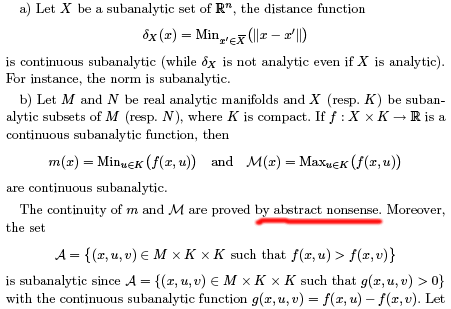"Logical abstract nonsense is a subfield of general abstract nonsense"
« previous post | next post »
According to the Wikipedia,
Abstract nonsense, or general abstract nonsense, is a popular term used by mathematicians to describe certain kinds of arguments and concepts in category theory or applications. The term goes back a long way, and even predates the foundation of category theory as a subject itself. Referring to a joint paper with Samuel Eilenberg that introduced the notion of a "category" in 1942, Saunders Mac Lane wrote the subject was 'then called "general abstract nonsense"'.
The term is believed to have been coined by the mathematician Norman Steenrod, himself one of the developers of the categorical point of view. This term is used by practitioners as an indication of mathematical sophistication or coolness rather than as a derogatory designation.
And it's true!
For example, from Laurent Niederman, "Hamiltonian stability and subanalytic geometry", Annales de l'institut Fourier, 56(3): 795-813, 2006:

And from Jean-Yves Béziau, Logica universalis: Towards a general theory of logic (2005), p. 14:

[Anton Cox comments:
As a professional mathematician, I hope you don't mind a few comments from me on "abstract nonsense".
The phrase is very commonly used informally or in seminars, but I would say relatively infrequently in print. Where I disagree with Wikipedia is on its meaning. Mathematicians have a different (and much more precise) meaning in mind that just 'sophisticated' or 'cool'.
Category theory is the study of abstract structures underlying other structures in maths. Thus one often finds that results are either specific to the particular context one is working in, or are a general feature of the categorical structures underneath. To say that something follows from/by abstract nonsense means that it is in the latter class, and so the result is some sense more basic or fundamental than the setting in which it is found. This is very helpful for an audience as it helps to keep track of the difference between the wood and the trees.
Categories consist of 'objects' and 'arrows' (where the arrows are regarded as functions from one object to another). Thus one often sees arguments where one is keeping track of the effect of various sequences of arrows. This leads to another semi-formal expression; to describe such a state of affairs one might say one is "diagram chasing" (a more precise description in this case than just "abstract nonsense").
In fact, the Wikipedia entry goes on to describe more-or-less precisely what kind of argument "by abstract nonsense" refers to. The point of the passage that I quoted was not that "abstract nonsense" just means "cool", but rather that the term is not at all derogatory in connotation. ]